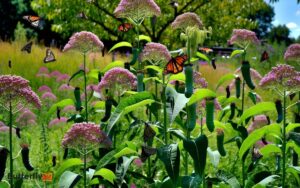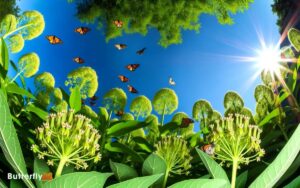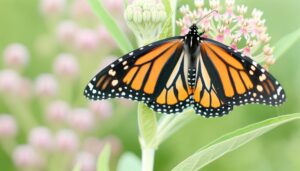What Is a Group of Monarch Butterflies Called?
A group of monarch butterflies is scientifically termed a 'roost'. This phenomenon occurs mainly during their migratory and overwintering phases when they cluster densely in specific locations, such as the oyamel fir forests of central Mexico.
These aggregations serve critical functions in thermoregulation, reducing energy expenditure, and minimizing predation risks. Roosts can encompass thousands of individuals, forming a visually striking and ecologically significant spectacle.
Understanding the dynamics and importance of these roosts provides insight into the survival strategies and migratory behavior of this iconic species. As we explore further, the intricate details of their life cycle and ecological roles unfold.

Key Takeaways
- A group of monarch butterflies is commonly referred to as a "cluster."
- During migration, monarchs form dense roosts or clusters on trees and shrubs.
- These clusters help with thermoregulation and reduce predation risks.
- Monarchs cluster in large numbers during overwintering in oyamel fir forests.
Monarch Butterfly Life Cycle
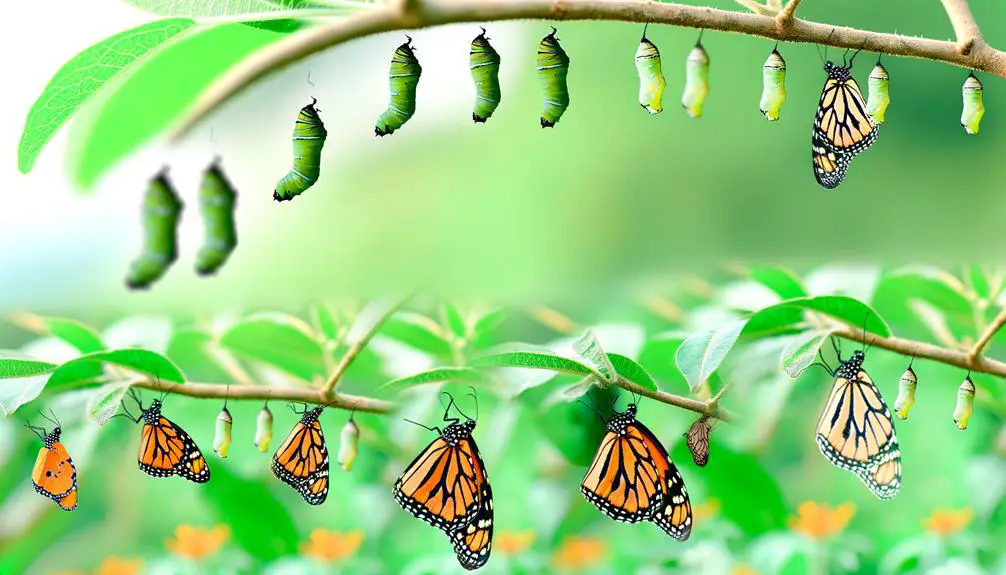
The life cycle of the Monarch butterfly (Danaus plexippus) encompasses four distinct stages: egg, larva (caterpillar), pupa (chrysalis), and adult butterfly.
Initially, the female deposits eggs on the underside of milkweed leaves, the sole food source for the larvae. Upon hatching, the larva undergoes five instars, each marked by molting, as it consumes milkweed voraciously.
Subsequently, the caterpillar forms a chrysalis, within which metamorphosis transpires. This pupa stage involves the reorganization of larval structures into adult morphology.
After approximately 10-14 days, the adult butterfly emerges, characterized by its vibrant orange and black wings.
This metamorphic journey underscores the Monarch's complex biological processes and adaptive strategies, offering profound insights into the intricacies of lepidopteran development.
Migration Patterns
Monarch butterflies exhibit remarkable migratory behavior, traveling thousands of miles between their breeding grounds in North America and overwintering sites in central Mexico. This migration is an extraordinary natural event involving multiple generations.
The journey is facilitated by an innate biological compass, enabling the butterflies to navigate using the sun's position and circadian rhythms. Monarchs can cover distances of up to 100 miles per day, utilizing thermal air currents for energy-efficient flight.
The migration spans several months, with the southward journey starting in late summer and culminating by November. This cyclical phenomenon guarantees the survival of the species, allowing them to exploit different ecological niches throughout the year, thereby embodying both resilience and the unrestrained spirit of nature.
Congregation Behavior
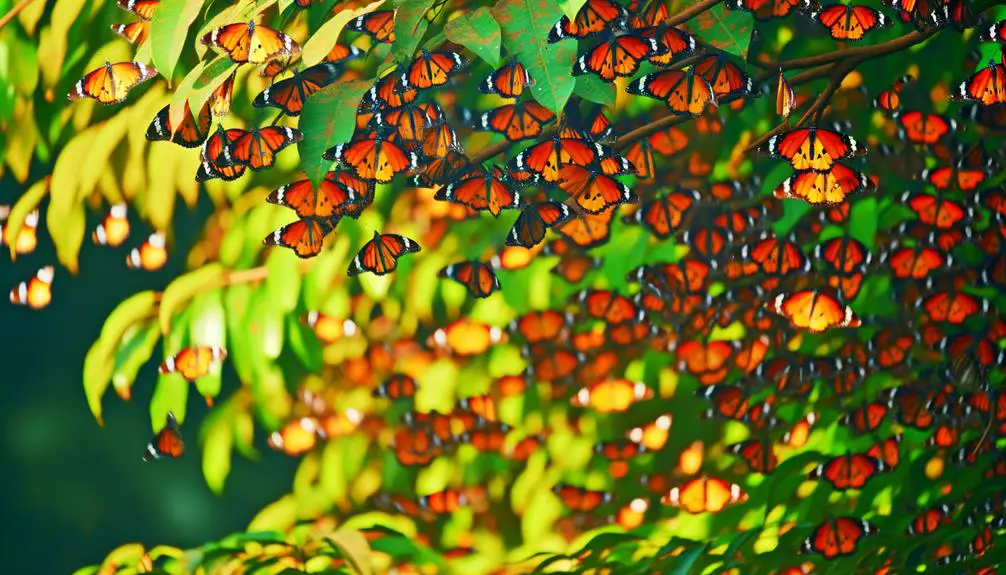
How do these exceptional insects exhibit congregation behavior during their migratory and overwintering phases?
Monarch butterflies demonstrate remarkable congregation behavior characterized by large-scale clustering. During migration, they form dense roosts at specific stopover sites, utilizing environmental cues such as temperature gradients and wind currents. These aggregations can number in the thousands, optimizing thermoregulation and reducing predation risks.
Upon reaching overwintering sites, particularly in oyamel fir forests in Mexico, monarchs engage in mass clustering on tree branches. This behavior minimizes energy expenditure by maintaining a stable microclimate and conserving heat.
Such congregation behavior is also pivotal for mating activities, ensuring the continuation of their migratory cycle. These intricate patterns underscore the monarch's adaptive strategies for survival and reproduction.
Terminology Explained
In the context of monarch butterfly migration and behavior, terminology such as 'roosting,' 'overwintering,' and 'thermoregulation' are essential for understanding the specific biological and ecological processes involved. Roosting refers to the behavior where butterflies cluster together on trees or shrubs, primarily during nighttime or adverse weather conditions. Overwintering is the period when monarchs migrate to warmer climates to survive the winter months. Thermoregulation is the process by which monarchs maintain their body temperature through behavioral adaptations, such as basking in the sun or seeking shade.
| Term | Definition |
|---|---|
| Roosting | Clustering together on trees or shrubs for rest or protection |
| Overwintering | Migration to warmer climates to survive winter |
| Thermoregulation | Behavioral adaptations to maintain body temperature |
Understanding these terminologies provides insight into the complexities of monarch butterfly behavior.
Historical Context
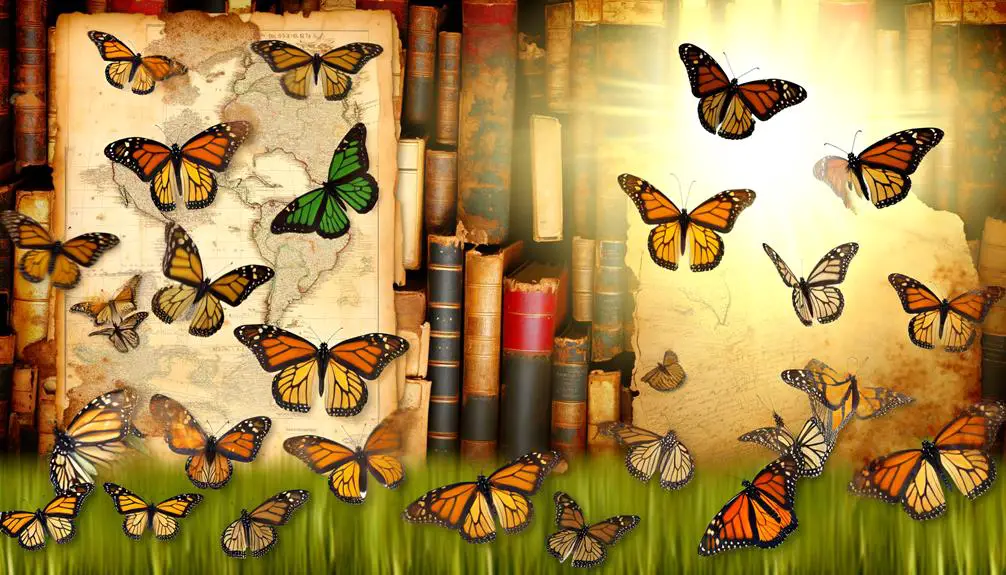
Historical records indicate that the migratory patterns of Monarch butterflies (Danaus plexippus) have captivated scientists since the 19th century, with early observations meticulously documented by naturalists.
The annual migration, spanning thousands of miles from North America to central Mexico, has not only been a subject of extensive scientific study but also holds profound cultural significance for indigenous communities.
These factors collectively underscore the importance of understanding Monarch migration within both ecological and anthropological frameworks.
Monarch Migration Patterns
Monarch migration patterns have been documented for centuries, revealing a complex and highly coordinated journey that spans thousands of miles across North America.
These butterflies commence a biannual migration, traveling from breeding grounds in Canada and the northern United States to overwintering sites in central Mexico.
The journey involves multiple generations, with each butterfly living only a few weeks except for the final generation, which enters a reproductive diapause, enabling them to survive the long trek.
Their navigation relies on a combination of environmental cues such as the angle of the sun and Earth's magnetic field.
This intricate migratory behavior underscores the monarch's remarkable adaptability and resilience, symbolizing a quest for survival and freedom across vast distances.
Early Observations Documented
Early documentation of monarch butterfly migration can be traced back to indigenous knowledge and the meticulous records of early naturalists. Indigenous peoples of North America recognized the cyclical patterns of these butterflies, observing their mass movements as harbingers of seasonal change.
In the 19th century, naturalists such as John Abbott and Samuel Scudder meticulously recorded monarch behaviors and migratory routes. Abbott's detailed illustrations and Scudder's thorough descriptions provided foundational scientific knowledge.
These early observations revealed the extensive migratory journey of monarchs, spanning from Canada to central Mexico. Such documentation was essential in understanding the complexity of their life cycle and migration, laying the groundwork for contemporary entomological studies and conservation efforts.
Cultural Significance Explored
Recognizing the profound cultural significance of monarch butterflies, various indigenous cultures and historical societies have revered these insects, integrating them into their myths, rituals, and seasonal celebrations.
The Aztecs, for instance, associated monarchs with the souls of warriors returning to visit their loved ones. In Michoacán, the arrival of monarchs coincides with the Day of the Dead, symbolizing the spirits of ancestors.
This intricate relationship underscores the monarch's role beyond mere ecological importance, embedding itself in the cultural fabric of societies. These butterflies serve as symbols of transformation, resilience, and the cyclical nature of life.
Such cultural reverence highlights the intrinsic value placed on monarchs, fostering a deeper understanding of their significance beyond biological and environmental contexts.
Ecological Importance
The ecological importance of monarch butterflies is underscored by their role as pollinators, contributing considerably to the health and diversity of ecosystems.
Through their foraging activities, monarchs facilitate the cross-pollination of various plant species, enhancing genetic diversity and resilience. This pollination process is critical for the reproduction of flowering plants, which serve as foundational components of many habitats.
Monarchs also occupy a pivotal niche in food webs, serving as prey for birds, spiders, and other predators. Their migratory patterns enable nutrient cycling across vast geographical areas, promoting ecosystem connectivity.
The decline in monarch populations could disrupt these ecological processes, underscoring the urgency for conservation efforts to maintain their integral ecological functions.
How to Observe
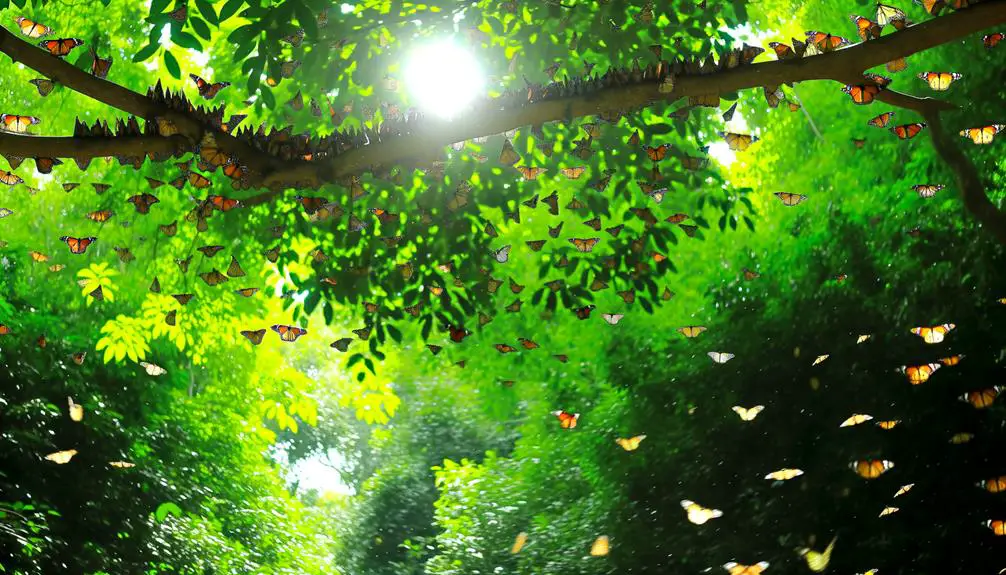
Observing monarch butterflies requires a systematic approach to maximize the chances of witnessing their behaviors and migratory patterns in their natural habitats.
Begin by identifying key migratory pathways, such as the Central Flyway in North America. Utilize resources like migration maps and tagging programs to predict peak observation periods.
Equip yourself with binoculars, field guides, and a camera with a zoom lens for detailed documentation. Select observation sites near milkweed plants, as these are essential for feeding and oviposition.
Maintain a respectful distance to avoid disrupting their natural activities. Recording environmental conditions, such as temperature, wind speed, and humidity, can provide valuable insights into their migratory triggers.
Engaging with local conservation groups can enhance observational efforts through shared data and expertise.
Conclusion
To sum up, the assemblage of monarch butterflies, known as a 'kaleidoscope,' encapsulates a remarkable phenomenon within the natural world.
From their intricate life cycle to their awe-inspiring migratory patterns, these lepidopterans exemplify ecological harmony and resilience.
Understanding their congregation behavior and historical context enhances the appreciation for their ecological importance.
Observing these ethereal creatures in their natural habitat offers invaluable insights into the delicate balance of ecosystems, underscoring the imperative for conservation efforts.

